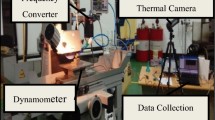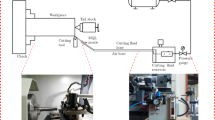Abstract
This paper focuses on using nanofluid (graphene)/ultrasonic atomization minimum quantity lubrication (MQL) in micromilling for SKH-9 high-speed steel. Utilizing the special properties of graphene, which has excellent thermal conductivity, it is found that it successfully lowers the cutting temperature generated during processing, reduces tool wear, and improves the quality of micromilling products. Using a self-developed ultrasonic atomization system effectively improves the agglomeration of nanoparticles in nanofluids and increases the lubrication efficiency of nanoparticles. The experimental plot is robustly designed, and the L18(21 × 37) orthogonal table is used to find the optimal combination of parameters. The control factors are the average thickness of the nanographene, density of nanofluid, spindle speed, distance of nozzle, feed rate, amount ultrasonic atomization, air pressure, nozzle angle, and using gray correlation analysis with fuzzy inference to find more heavy quality characteristics. Finally, the optimal parameter combination of multi-quality characteristics enhanced by nanofluid (graphene)/ultrasonic atomization MQL is compared with the base fluid/ultrasonic atomization MQL, nanofluid (MWCNTs)/ultrasonic atomization MQL, whereas the differences in micromilling force, temperature, tool wear, and workpiece burr are discussed. The results indicate that the use of nanofluid (graphene)/ultrasonic atomization MQL has better results than other lubrication methods.















Similar content being viewed by others
References
Kang, I.S., Kim, J.S., Kim, J.H., Kang, M.C., Seo, Y.W.: A mechanistic model of cutting force in the micro end milling process. J. Mater. Process. Technol. 187, 250–255 (2007)
Tanaka, M.: Development of desktop machining microfactory. Riken Rev. 34, 46–49 (2001)
Debnath, S., Reddy, M.M., Yi, Q.S.: Influence of cutting fluid conditions and cutting parameters on surface roughness and tool wear in turning process using Taguchi method. Measurement 78, 111–119 (2016)
Chan, C.Y., Lee, W.B., Wang, H.: Enhancement of surface finish using water-miscible nano-cutting fluid in ultra-precision turning. Int. J. Mach. Tools Manuf. 73, 62–70 (2013)
Davoodi, B., Tazehkandi, A.H.: Experimental investigation and optimization of cutting parameters in dry and wet machining of aluminum alloy 5083 in order to remove cutting fluid. J. Cleaner Prod. 68, 234–242 (2014)
Sutherland, J.W., Kulur, V.N., King, N.C., Von Turkovich, B.F.: An experimental investigation of air quality in wet and dry turning. CIRP Ann. Manuf. Technol. 49(1), 61–64 (2000)
Banerjee, N., Sharma, A.: Identification of a friction model for minimum quantity lubrication machining. J. Cleaner Prod. 83, 437–443 (2014)
Jiang, Z., Zhou, F., Zhang, H., Wang, Y., Sutherland, J.W.: Optimization of machining parameters considering minimum cutting fluid consumption. J. Cleaner Prod. 108, 183–191 (2015)
Debnath, S., Reddy, M.M., Yi, Q.S.: Environmental friendly cutting fluids and cooling techniques in machining: a review. J. Cleaner Prod. 83, 33–47 (2014)
Weinert, K., Inasaki, I., Sutherland, J.W., Wakabayashi, T.: Dry machining and minimum quantity lubrication. Ann. CIRP 53, 511–537 (2004)
Huang, W.T., Wu, D.H., Chen, J.T.: Robust design of using nanofluid/MQL in micro-drilling. Int. J. Adv. Manuf. Technol. 85, 2115–2161 (2016). https://doi.org/10.1007/s00170-015-7382-x
Huang, W.T., Wu, D.H., Lin, S.P., Liu, W.S.: A combined minimum quantity lubrication and MWCNT cutting fluid approach for SKD 11 end milling. Int. J. Adv. Manuf. Technol. 84, 1697–1704 (2016)
Duchosal, A., Serra, R., Leroy, R., Hamdi, H.: Numerical optimization of the Minimum Quantity Lubrication parameters by inner canalizations and cutting conditions for milling finishing process with Taguchi method. J. Cleaner Prod. 108, 65–71 (2015)
Sarıkaya, M., Güllü, A.: Multi-response optimization of minimum quantity lubrication parameters using Taguchi-based grey relational analysis in turning of difficult-to-cut alloy Haynes 25. J. Cleaner Prod. 91, 347–357 (2015)
Giasin, K., Ayvar-Soberanis, S., Hodzic, A.: The effects of minimum quantity lubrication and cryogenic liquid nitrogen cooling on drilled hole quality in GLARE fibre metal laminates. Mater. Des. 89, 996–1006 (2016)
Dureja, J.S., Singh, R., Singh, T., Singh, P., Dogra, M., Bhatti, M.S.: Performance evaluation of coated carbide tool in machining of stainless steel (AISI 202) under minimum quantity lubrication (MQL). Int. J. Prec. Eng. Manuf. -Green Technol. 2(2), 123–129 (2015)
Pu, J.B., Wang, L.P.: XUE Qun-ji. Tribolog 34(1), 93–112 (2008)
Ramisetty, K.A., Pandit, A.B., Gogate, P.R.: Investigations into ultrasound induced atomization. Ultrason. Sonochem. 20(1), 254–264 (2013)
Huang, W.T., Liu, W.S.: Jun). Investigations into lubrication in grinding processes using MWCNTs nanofluids with ultrasonic-assisted dispersion. J. Cleaner Prod. (SCI) 137, 1553–1559 (2016)
Huang, W.T., Liu, W.S., Tsai, J.T., Chou, J.H.: Multiple quality characteristics of nanofluid/ultrasonic atomization minimum quality lubrication for grinding hardened mold steel. IEEE Trans. Auto. Sci. Eng. 15(3), 1065–1077 (2018). https://doi.org/10.1109/tase.2017.2726000
Dourado, A.D., Lobato, F.S., Cavalini, A.A., et al.: Fuzzy reliability-based optimization for engineering system design. Int. J. Fuzzy Syst. 21, 1418–1429 (2019). https://doi.org/10.1007/s40815-019-00655-5
Liu, J., Chen, Y., Zhou, J., et al.: An exact expected value-based method to prioritize engineering characteristics in fuzzy quality function deployment. Int. J. Fuzzy Syst. 18, 630–646 (2016). https://doi.org/10.1007/s40815-015-0118-0
Burton, G., Goo, C.S., Zhang, Y., Jun, M.B.: Use of vegetable oil in water emulsion achieved through ultrasonic atomization as cutting fluids in micro-milling. J. Manuf. Processes 16(3), 405–413 (2014)
Ding, Y., Wen, D.: Particle migration in a flow of nanoparticle suspensions. Powder Technol. 149(2), 84–92 (2005)
Kumar, M.N., Mahmoodi, M., TabkhPaz, M., Park, X., Jin, S.S.: Characterization and micro end milling of graphene nano platelet and carbon nanotube filled nanocomposites. J. Mater. Process. Tech. 249, 96–107 (2017)
Huang, W.T., Chou, F.T., Tsai, J.T., Lin, T.W., Chou, J.H.: Optimal design of parameters for the nanofluid/ultrasonic atomization minimal quantity lubrication in a micro-milling process. IEEE Trans. Industr. Inf. (2019). https://doi.org/10.1109/TII.2019.2955736
Acknowledgements
This work was supported in part by the Ministry of Science and Technology, Taiwan, R.O.C., under Grant Numbers MOST 109-2221-E-020 -019 -MY2, MOST 108-2637-E-020-008, and MOST 107-2221-E-992-086-MY3. This work was supported in part by the Headquarters of University Advancement and Intelligent Manufacturing Research Center (iMRC), National Cheng Kung University, which are sponsored by the Ministry of Education, Taiwan, R.O.C.
Author information
Authors and Affiliations
Corresponding authors
Rights and permissions
About this article
Cite this article
Huang, WT., Chou, FI., Tsai, JT. et al. Application of Graphene Nanofluid/Ultrasonic Atomization MQL System in Micromilling and Development of Optimal Predictive Model for SKH-9 High-Speed Steel Using Fuzzy-Logic-Based Multi-objective Design. Int. J. Fuzzy Syst. 22, 2101–2118 (2020). https://doi.org/10.1007/s40815-020-00930-w
Received:
Revised:
Accepted:
Published:
Issue Date:
DOI: https://doi.org/10.1007/s40815-020-00930-w




